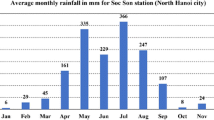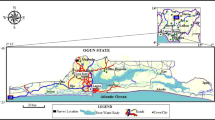Abstract
An integrated surface geophysical and physicochemical study involving 2-D electrical resistivity imaging (terrain conductivity measurement using EM34-3) complimented with measurement of some physical parameters was conducted at Olushosun sanitary landfill site in Lagos metropolis, southwestern Nigeria, with the aim of investigating the lateral extent and depth of the possible subsurface leachate contamination plumes (electrically conductive anomalies) within the area. Fourteen 2-D resistivity imaging lines were investigated with a maximum spread length of 249 m per line. The result of the resistivity imaging delineated the contaminant plume as low-resistivity zones (0.24–36 Ωm) to a maximum depth of 59 m. The electrical resistivity tomography (ERT) lines were projected to produce stacked block models of the site which show southeast flow pattern of the leachate and, possibly, the groundwater flow direction. Eleven electromagnetic (EM) profiles were established with a maximum spread length of 150 m per profile using both the vertical and horizontal dipole configurations to measure terrain conductivity of the study area; 10, 20, and 40 m coil separations were deployed for the measurement. Qualitative interpretation of the EM34-3 data reveals high conductivity range of values (30–264 mmho/m) within the dumpsite as compared to conductivity values ranging between 4 and 26 mmho/m for the control site. It delineated the vertical extent of the contaminated zones up to a maximum depth of about 30 m (horizontal dipole configuration) and a maximum depth of about 60 m (vertical dipole configuration). Physicochemical analysis of the water samples taken from wells and boreholes within the precinct of the dumpsite reveal an elevation in concentrations of total dissolved solid (TDS) (range of 513–2,000 mg/l) and electrical conductivity (EC) (range of 1,019–3,999 μS/m) in wells 4, 7, 10, 11, 15, 16, and 19 with the values obtained moderately above the WHO standards. The pH obtained from water samples indicates high acidic content (5.34–6.85). These possibly indicate contamination of the groundwater as a result of solid waste leachate accumulation, thus complimenting the geophysical data. Leachate flow direction was generated from the increasing concentration of TDS and EC in southeast direction which agrees with similar flow pattern deduced from ERT results.











Similar content being viewed by others
References
Adeleye DR (1975) Nigeria late cretaceous stratigraphy and paleography. AAPG Bull 59(12):2302–2313
AGI inversion software (2009)
Ayolabi EA (2005) Geoelectric evaluation of Olushosun landfill site, southwest Nigeria and its implications on groundwater. J Geol Soc India 66:318–322
Ayolabi EA, Peters DY (2005) Hydrochemical and electrical resistivity assessment of the impact of solid waste on the groundwater at Oke-alfa refuse dumpsite, Lagos, Nigeria. J Sci Eng 12(1):5936–5946
Billman HG (1992) Offshore Stratigraphy and Paleontology of the Dahomey Embayment, West Africa, N.A.P.E. Bulletin 7(2):121–130
Davis JL, Annan AP (1989) Ground penetrating radar for high-resolution mapping of soil and rock stratigraphy. Geophys Prospect 37(5):531–551
Dawson CB, Lane JW Jr., White EA, Belaval M (2002) Integrated geophysical characterization of the Winthrop landfill southern flow path, Winthrop, Maine: Symposium on the Application of Geophysics to Engineering and Environmental Problems (SAGEEP) 2002 annual meeting of EEGS, Las Vegas, Nevada, February 10–14, 2002
deGroot-Hedlin C, Constable C (1990) Occam’s inversion to generate smooth two-dimensional models from magnetotelluric data. Geophysics 55(12):1613–1624
Elueze AA, Nton ME (2004) Organic geochemical appraisal of limestones and shales in part of Eastern Dahomey Basin, Southwestern Nigeria. J Min Geol 40(1):29–40
Greenhouse JP, Harris RD (1983) DC, VLF and inductive resistivity surveys, in migration of contaminants in groundwater at a landfill: a case study. J Hydrol 63:190–197
Greenhouse JP, Monier-Williams M (1985) Geophysical monitoring of groundwater contamination around waste disposal sites. Groundw Monit Rev 5(4):47–59
Greenhouse JP, Slaine DD (1983) The use of reconnaissance electromagnetic methods to map contaminant migration”. Ground Water Monit Rev 3(2):47–59
Jones HA, Hockey RD (1964) The geology of the part of southwestern Nigeria. Geological Survey Nigeria Bulletin, No 31, pp 101
Keller GV, Frischnecht FC (1966) Electrical methods in geophysical prospecting. Pergamon, Oxford, p 523
King WC, Witten AJ, Reed GD (1989) Detection and imaging of buried wastes using seismic wave propagation”. J Environ Eng 115(3):527–540
Lagos Metropolitan Development and Governance Project LMDGP (2009) Solid waste management component. Environmental and Social Impact Assessment (ESIA). Ministry of the Environment Lagos State Secretariat, Alausa, pp 11–70
Loke M H (2004) Tutorial: 2-D and 3-D electrical imaging surveys. 2004 revised edition. www.geometrics.com
Loke MH, Barker RD (1996) Practical techniques for 3D resistivity surveys and data inversion. Geophys Prospect 44:499–524
Longe EO, Malomo S, Olorunniwo MA (1987) Hydrogeology of Lagos metropolis. J Afr Earth Sci 6(3):163–174
Ogbe FGA (1972) Stratigraphy of strata exposed in the Ewekoro quarry, southwestern Nigeria. In: Dessauvagie TFJ, Whiteman (eds) African geology. University Press, Nigeria, p 305
Pastor J, Hernández AJ (2012) Heavy metals, salts and organic residues in old solid urban waste landfills and surface waters in their discharge areas: determinants for restoring Their impact. J Environ Manag 98:S42–S49. doi:10.1016/j.jenvman.2011.06.048
Ross HP, Mackelprang CE, Wright PM (1990) Dipole-dipole electrical resistivity surveys at waste disposal study site in Utah. In: Ward SH (ed) Geotechnical and environmental geophysics, vol 2. Society of Exploration Geophysicists, Tulsa, pp 145–152
Slaine DD, Greenhouse JP (1982) “Case histories of geophysical contaminant mapping at several waste disposal sites.” Proceedings of the Second National Symposium on Aquifer Restoration and Ground Water Monitoring. 26–28 May, 1982. Columbus, pp 299–315
Slaine DD, Pehme PE, Hunter JA, Pullan SE, Greenhouse JP (1990) Mapping overburden stratigraphy at a proposed hazardous waste facility using seismic reflection methods. In: Ward SH (ed) Geotechnical and environmental geophysics, vol. 2. Environmental and Groundwater. Society of Exploration Geophysicists, Tulsa, pp 273–280
Sweeney JJ (1984) Comparison of electrical resistivity methods for investigation of groundwater conditions at a landfill site. Groundw Monit Rev 4(1):52–59
Wait JR (1962) A note on the electromagnetic response of a stratified earth. Geophysics 27:382–385
Winglink (2003) Integrated interpretation software. Geosystem, Italy
Winglink (2007) Integrated interpretation software. Version 2.20.01. Geosystem Corporation, Milan
World Health Organization-WHO (2006) Guidelines for drinking water quality. Geneva. www.lawma.gov.ng/landfill
Author information
Authors and Affiliations
Corresponding author
Rights and permissions
About this article
Cite this article
Ayolabi, E.A., Oluwatosin, L.B. & Ifekwuna, C.D. Integrated geophysical and physicochemical assessment of Olushosun sanitary landfill site, southwest Nigeria. Arab J Geosci 8, 4101–4115 (2015). https://doi.org/10.1007/s12517-014-1486-8
Received:
Accepted:
Published:
Issue Date:
DOI: https://doi.org/10.1007/s12517-014-1486-8




